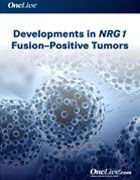Publication
Article
Special Issues
Expert Hails NRG1 Fusions as the "Next Big Target" in Oncology
Author(s):
NRG1 fusions occur in low frequency across solid tumors, and because these alterations can evade traditional sequencing modalities, RNA-based next-generation sequencing is imperative.
Stephen V. Liu, MD

Stephen Liu, MD
NRG1 fusions occur in low frequency across solid tumors, and because these alterations can evade traditional sequencing modalities, RNA-based next-generation sequencing (NGS) is imperative, said Stephen Liu, MD. Among those in whom these fusions are identified, afatinib (Gilotrif) has shown notable antitumor activity.
“We presented 7 case reports at the 2019 ESMO Congress in which the use of afatinib, a pan-ErbB inhibitor, showed very rapid, very dramatic, and in some cases, very durable responses lasting 2 years or longer. These are all of the [boxes] we're looking [to check] with targeted therapy,” said Liu.
However, due to the limited generalizability of case series, more data are needed to characterize the true activity of afatinib. To that end, ASCO’s TAPUR trial is treating patients whose tumors express NRG1 fusions with afatinib to prospectively assess the safety and activity of the drug.
In an interview with OncLive, Liu, associate professor of medicine, Division of Hematology and Oncology, Georgetown University Medical Center, discussed the known incidence of NRG1 fusion—positive cancers and the work being done to match targeted treatments with this patient subset.
OncLive: Could you discuss the prevalence of NRG1 fusions in oncology?
Liu: NRG1 fusions are transforming oncogenic events that occur at a very low incidence across tumor types. These fusions can be seen in non—small cell lung cancer (NSCLC), breast cancer, colon cancer, pancreatic cancer, and cholangiocarcinoma—really, a multitude of tumor types. They are detected in less than 1% [of cancers]; approximately 0.2% or 0.3% of all tumors will have an NRG1 fusion. However, NRG1 fusions do have transforming potential. When we target that pathway, we see pretty dramatic results.
NRG1 fusions consist of 2 portions: the NRG1 portion, which contains an EGFR-like ligand, and the fusion partner, which is responsible for tethering the ligand to the plasma membrane. When localized to the plasma membrane, the ligand will interact with HER3 or HER4, which will then heterodimerize, induce phosphorylation, and signal transduction through the MAPK and PI3K pathways. That leads to [malignant] cell proliferation and survival. If we can interrupt that pathway in these fusion—positive tumors, we can induce an antitumor effect, and that's what we're seeing.
NRG1 is a true target; it’s a target we can go after and exploit therapeutically with drugs like afatinib. Moreover, other drugs are targeting the HER3 pathway, including monoclonal antibodies, bispecific [T-cell engagers], and antibody—drug conjugates; a whole multitude of strategies are being examined in an effort to target these fusions. Our suspicion is that [NRG1 fusions] don’t respond as well to strategies such as immunotherapy or other standard options.
NRG1 is a new [target] that needs to be identified in order to be managed appropriately. In order to identify all of these cases, you need to use RNA-based NGS. You’ll often miss [NRG1 fusions] with DNA-based sequencing. Once identified, you should try to identify a trial to match [the patient with an appropriate targeted therapy]. NRG1 will be the next big target throughout oncology.
What is the current prognosis of these patients?
We don't really know many of those details yet. Patients with NRG1 fusion—positive lung cancer generally fit the phenotype that we look for with targeted therapy. [Patients are generally] nonsmokers, younger, and have nonsquamous histology. We need to identify the natural history of the disease and determine how patients respond to current standards so we can figure out how to improve upon that with additional targeted therapies. We still have a lot to learn regarding what a patient with an NRG1 fusion looks like. Without any good phenotypic clues, we need to do RNA sequencing in order to identify these patients.
Could you speak to the efficacy of afatinib in this patient subset?
We’ve added 7 more case reports to the 7 that had been published previously, and we showed pretty rapid [and durable] responses with afatinib. One patient had a response lasting 2 years. At progression, they were treated with other systemic therapies and then retreated with afatinib. We saw a response that was very similar to [that achieved with] other targeted agents. [At the 2019 ESMO Congress], we reported on 4 cases of NSCLC. [NRG1] fusions seem to be a little more frequent in invasive mucinous adenocarcinoma, but we do see them in other tumor types. We also reported [the first incidence of an NRG1 fusion] in colorectal cancer, as well as 2 cases in KRAS wild-type pancreatic cancers.
The NRG portion seems to be fairly constant, but the fusion partner can be quite variable. While the most common partner is CD74, there are many different fusion partners and splice variants.
Could you discuss the goal of the ongoing TAPUR trial?
The TAPUR trial is ASCO’s first clinical trial; it’s a prospective study that’s using genomic information to assign patients to various treatments. It’s a precision medicine basket study. As we learn more about these targets, identify new targets and new drugs, the study will evolve. One of the arms in TAPUR is for patients with NRG1 fusions, and they’ll receive afatinib. [With this trial, we hope to learn] the true response rate, progression-free survival, and overall survival of these patients on afatinib.
What are the next steps for this research?
We've seen that afatinib can be an effective treatment in patients with NRG1 fusion—positive cancer, but we don’t know what the true response rate is [with this agent in this population]. With case reports, there’s no denominator. We’re only seeing positive cases. We don't know how frequently afatinib works, so we need more prospective studies like TAPUR. With these data, we’ll be able to characterize responses to afatinib in a more comprehensive and methodic way. Prospective studies are really what's needed to determine afatinib’s true place in the management of these tumors.
In NSCLC, we're already past the tipping point [of personalized medicine]. We know NGS is the proper testing method to detect multiple alterations rather than doing parallel testing or sequential testing for EGFR, ALK, ROS, and so forth. If you do RNA-based NGS, you could find NRG1, RET, HER2, and other important alterations in addition to EGFR, ALK, ROS, BRAF, and NTRK.
Liu SV, Duruisseaux M, Tolba K, et al. Targeting NRG1—fusions in multiple tumour types: afatinib as a novel potential treatment option. Ann Oncol. 2019;30(5 suppl, abstr 1969P). doi: 10.1093/annonc/mdz268.096.










